
Caldo Gallego – (Caldo Gallego recipe follows along with instructions and video tutorial) – Caldo Gallego is another one of those dishes that I am addicted to as a direct result of my mother-in-laws’ fabulous cooking. She makes this every year as soon as the weather starts to get cold - well, cold for us here in Phoenix. I know you Northerners are laughing when I say cold and it’s 70°F out. Anyway, Caldo Gallego is a beautiful Spanish Soup which is also very common in Puerto Rico. It traditionally is made with cabbage, potatoes and beans and can also have meat. Which meat varies slightly by family. I would say the most usual meats used though would be pork, ham and chorizo. Actually, to me, the chorizo is kind of mandatory. First of all because it is soooooo good. And second, because it adds a ton of flavor. You need to know that we’re talking about Spanish Chorizo here though. No, Chorizo is not all the same, at all. You see, Spanish Chorizo is made from chopped (not ground) pork and pork fat, which has been seasoned with smoked paprika and salt, using smoked dried red peppers and white wine. Yummy! It is also usually dry – cured and doesn’t require further cooking (although we are going to cook it for this recipe). Of course, there are tons of regional variations of chorizo if you’re lucky enough to be in Spain or travel there including smoked and un-smoked, cooked and raw and garlic and so on, but what we need to know about is what we can get easily here right? 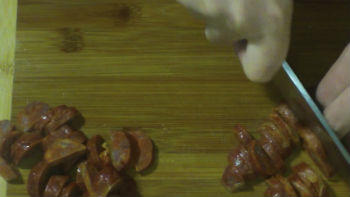 You should also know that I’m not using a spicy chorizo, you can , but I”m not. You can tell if they are sweet or spicy by the shape of the sausage. If it is long and thin, it is sweet, if it is short and fatter, it is spicy. Again this is a general rule and not every sausage maker follows this general rule (sausage making is an art too ya know). And actually, you’ll notice that the chorizo I use is short and fat and doesn’t follow the rule. OK, I told you about Spanish Chorizo, so I just want to make a quick comparison for you to Mexican Chorizo even though this is not an article about chorizo (Is it turning into one?) Anyway, Mexican Chorizo is generally made without the smoked paprika and the white wine is usually replaced by vinegar. Oh, and the pork is ground, not chopped and is not cooked or cured. So, you’re getting a raw meat (usually) if you buy Mexican Chorizo. Which by the way is also yummy, just not necessarily in this soup. So back to the name – Caldo Gallego. Well, Caldo Gallego translates to Galician Broth. Galicia is located in the Northwestern corner of Spain. It is historically one of the poorest areas of Spain. In Spanish the Galacians are called “Gallegos”. One of the dishes they are famous for is – you guessed it, Caldo Gallego. There it is made with cabbage, potatoes and beans. They may also add the meats pork, chorizo, or ham, but not always. Like I said, it is one of the poorest parts of Spain. Today, we will be adding meat :D Last but not least, as I mentioned earlier, my mother-in-law makes this. This is not her recipe, but definitely is inspired by it (I’m a Chef after all, I can’t help but make some changes) so she deserves some of the credit. So, thank you Mirta for introducing me to this delicious soup. I think you’ll be proud.
You should also know that I’m not using a spicy chorizo, you can , but I”m not. You can tell if they are sweet or spicy by the shape of the sausage. If it is long and thin, it is sweet, if it is short and fatter, it is spicy. Again this is a general rule and not every sausage maker follows this general rule (sausage making is an art too ya know). And actually, you’ll notice that the chorizo I use is short and fat and doesn’t follow the rule. OK, I told you about Spanish Chorizo, so I just want to make a quick comparison for you to Mexican Chorizo even though this is not an article about chorizo (Is it turning into one?) Anyway, Mexican Chorizo is generally made without the smoked paprika and the white wine is usually replaced by vinegar. Oh, and the pork is ground, not chopped and is not cooked or cured. So, you’re getting a raw meat (usually) if you buy Mexican Chorizo. Which by the way is also yummy, just not necessarily in this soup. So back to the name – Caldo Gallego. Well, Caldo Gallego translates to Galician Broth. Galicia is located in the Northwestern corner of Spain. It is historically one of the poorest areas of Spain. In Spanish the Galacians are called “Gallegos”. One of the dishes they are famous for is – you guessed it, Caldo Gallego. There it is made with cabbage, potatoes and beans. They may also add the meats pork, chorizo, or ham, but not always. Like I said, it is one of the poorest parts of Spain. Today, we will be adding meat :D Last but not least, as I mentioned earlier, my mother-in-law makes this. This is not her recipe, but definitely is inspired by it (I’m a Chef after all, I can’t help but make some changes) so she deserves some of the credit. So, thank you Mirta for introducing me to this delicious soup. I think you’ll be proud.
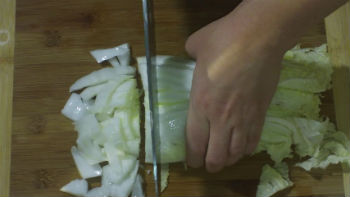 Ingredients
Ingredients
3/4 pound dried white beans
1 pound of ham
3.5 ounce package links of Spanish Chorizo
1/4 pound bacon (not traditional, but yummy)
1 medium onion, sliced
1 ham bone
2 quarts chicken or vegetable stock
water
1 bay leaf
3/4 teaspoon Kosher Salt 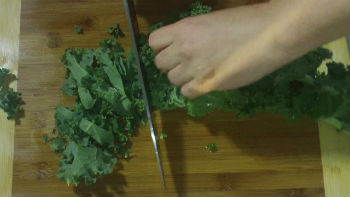
1/4 teaspoon black pepper, fresh ground
1 pound potatoes, small dice (cut bite size)
1 pound Napa cabbage (green cabbage is fine too)
1 bunch Kale (you can also use turnip greens or collard greens)
Instructions
1. Spread the beans out on a plate or sheet pan and look through them for any pebbles (yep, sometimes they get in there), and any bad beans. Soak your beans in water over night. It is better if you can change the water at least once. I changed mine like five times. *See note after the recipe.
2. Drain the beans and rinse them thoroughly. Drain them again and set them to the side.
3. In a large pot, saute the bacon until it’s about half way done. 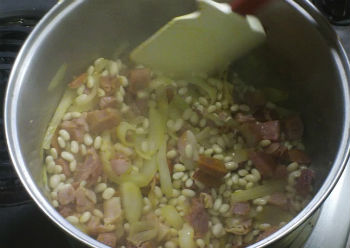
4. If needed, add a little of the stock or water to deglaze the pan and scrape up the fond (that means you add maybe 1/4 cup of the stock to the hot pan and scrape the bottom of the pan to remove all the little brown bits that may have formed there, they’re full of flavor and we want them in the stew). If you don’t have anything sticking to the bottom of the pot, just move on to the next step.
5. Once you have deglazed the pan, add the ham and chorizo and saute for about one minute. Then add the onion. “Sweat the onion”. That’s Chef talk for cook the onion until it’s translucent.
6. Add the beans and stir. Then add the ham bone and the rest of the stock. If your ham bone isn’t covered, add some water until it is (up to two cups). Add the bay leaf, salt and pepper.
7. Bring this to a boil and then reduce the heat and cover the pot with a lid. Let it simmer for two hours.
8. Add the potatoes and return the stew to a boil.
9. Reduce the heat and allow the stew to simmer for about another 20 minutes partially covered.
10. Add the cabbage and simmer for 15 more minutes, uncovered.
11. Add the chopped Kale. When the Kale is done, so is the stew. You want the Kale to have a nice bright color and it shouldn’t take more then five minutes.
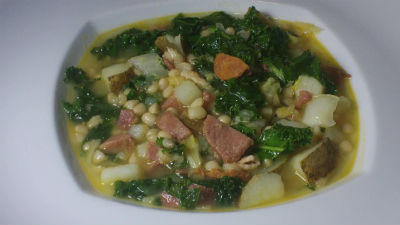 Why do you soak and drain your beans (and change the water and all that)?
Why do you soak and drain your beans (and change the water and all that)?
The answer is simple and not so simple. The simple answer-you don’t want to give everyone gas. The not so simple answer-beans contain oligosaccharides. This is a sugar that, because of its large molecular size, our bodies don’t break down. It makes its’ way through our small intestines where most sugars are absorbed and into our large intestine. When it makes its way into our large intestine, the bacteria that live there have a small party (they never get sugar, so it’s a treat). They process the oligosaccharide, this produces gas-not so good. The sugar is water soluble though – Yay! That means that if you soak your beans and change the water, you pour the oligosaccharide down the drain. This is also why it’s important to change the water. The water can only “hold” so much. It’s kind of like when you dissolve salt in water for a brine, if you put in too much, it doesn’t all dissolve. Also, don’t cook the beans in the soaking water. It defeats the purpose!
Please enjoy this how-to video!




